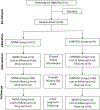Movement pattern biofeedback training after total knee arthroplasty: Randomized clinical trial protocol
- PMID: 32171937
- PMCID: PMC7263966
- DOI: 10.1016/j.cct.2020.105973
Movement pattern biofeedback training after total knee arthroplasty: Randomized clinical trial protocol
Abstract
Introduction: Total knee arthroplasty (TKA) reduces joint symptoms, but habitual movement compensations persist years after surgery. Preliminary research on movement training interventions have signaled initial efficacy for remediating movement compensations and restoring knee joint loading symmetry during dynamic functional tasks after TKA. The purpose of this clinical trial is to determine if physical rehabilitation that includes movement training restores healthy movement patterns after TKA and reduces the risk of osteoarthritis (OA) progression in the contralateral knee.
Methods/design: 150 participants will be enrolled into this randomized controlled trial. Participants will be randomly allocated to one of two dose-equivalent treatment groups: standard rehabilitation plus movement training (MOVE) or standard rehabilitation without movement training (CONTROL). Movement training will promote between-limb symmetry and surgical knee loading during activity-based exercises. Movement training strategies will include real-time biofeedback using in-shoe pressure sensors and verbal, visual, and tactile cues from the physical therapist. The primary outcome will be change in peak knee extension moment in the surgical knee during walking, from before surgery to six months after surgery. Secondary outcomes will include lower extremity movement symmetry during functional tasks, physical function, quadriceps strength, range of motion, satisfaction, adherence, contralateral knee OA progression, and incidence of contralateral TKA.
Discussion: This study will provide insights into the efficacy of movement training after unilateral TKA, along with mechanisms for optimizing long-term physical function and minimizing negative sequelae of compensatory movement patterns.
Keywords: Biofeedback; Joint replacement; Osteoarthritis; Physical therapy; Rehabilitation.
Published by Elsevier Inc.
Similar articles
-
Movement Pattern Biofeedback Training After Total Knee Arthroplasty: A Randomized Controlled Trial.Arthritis Care Res (Hoboken). 2025 Jun;77(6):732-743. doi: 10.1002/acr.25489. Epub 2025 Jan 25. Arthritis Care Res (Hoboken). 2025. PMID: 39711097 Clinical Trial.
-
Effects of Weight-Bearing Biofeedback Training on Functional Movement Patterns Following Total Knee Arthroplasty: A Randomized Controlled Trial.J Orthop Sports Phys Ther. 2015 Sep;45(9):647-55. doi: 10.2519/jospt.2015.5593. Epub 2015 Jul 24. J Orthop Sports Phys Ther. 2015. PMID: 26207975 Free PMC article. Clinical Trial.
-
Does the addition of hip strengthening exercises improve outcomes following total knee arthroplasty? A study protocol for a randomized trial.BMC Musculoskelet Disord. 2016 Jun 13;17:259. doi: 10.1186/s12891-016-1104-x. BMC Musculoskelet Disord. 2016. PMID: 27295978 Free PMC article. Clinical Trial.
-
The Effects of Balance Training on Balance Performance and Functional Outcome Measures Following Total Knee Arthroplasty: A Systematic Review and Meta-Analysis.Sports Med. 2018 Oct;48(10):2367-2385. doi: 10.1007/s40279-018-0964-7. Sports Med. 2018. PMID: 30117054
-
Training with biofeedback devices improves clinical outcome compared to usual care in patients with unilateral TKA: a systematic review.Knee Surg Sports Traumatol Arthrosc. 2019 May;27(5):1611-1620. doi: 10.1007/s00167-018-5217-7. Epub 2018 Oct 17. Knee Surg Sports Traumatol Arthrosc. 2019. PMID: 30334150
Cited by
-
Longitudinal study of knee load avoidant movement behavior after total knee arthroplasty with recommendations for future retraining interventions.Knee. 2021 Jun;30:90-99. doi: 10.1016/j.knee.2021.03.014. Epub 2021 Apr 17. Knee. 2021. PMID: 33878682 Free PMC article.
-
Mobile and Computer-Based Applications for Rehabilitation Monitoring and Self-Management After Knee Arthroplasty: Scoping Review.JMIR Mhealth Uhealth. 2024 Jan 26;12:e47843. doi: 10.2196/47843. JMIR Mhealth Uhealth. 2024. PMID: 38277195 Free PMC article.
-
Movement Pattern Biofeedback Training After Total Knee Arthroplasty: A Randomized Controlled Trial.Arthritis Care Res (Hoboken). 2025 Jun;77(6):732-743. doi: 10.1002/acr.25489. Epub 2025 Jan 25. Arthritis Care Res (Hoboken). 2025. PMID: 39711097 Clinical Trial.
-
Concurrent Force Feedback on Load Symmetry in Total Knee Arthroplasty Patients.Int J Sports Phys Ther. 2023 Aug 1;18(4):856-863. doi: 10.26603/001c.84312. eCollection 2023. Int J Sports Phys Ther. 2023. PMID: 37547847 Free PMC article.
References
-
- Most Frequent Operating Room Procedures Performed in U.S. Hospitals, 2003–2012 2012. https://www.hcup-us.ahrq.gov/reports/statbriefs/sb186-Operating-Room-Pro....
-
- Kurtz S, Projections of Primary and Revision Hip and Knee Arthroplasty in the United States from 2005 to 2030, The Journal of Bone and Joint Surgery (American) 89(4) (2007) 780. - PubMed
-
- Farquhar SJ, Reisman DS, Snyder-Mackler L, Persistence of Altered Movement Patterns During a Sit-to-Stand Task 1 Year Following Unilateral Total Knee Arthroplasty, Phys. Ther. 88(5) (2008) 567–579. - PubMed


